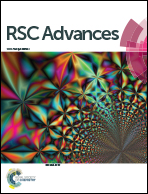Electroreduction-based Tb extraction from Tb4O7 on different substrates: understanding Al–Tb alloy formation mechanism in LiCl–KCl melt
Abstract
This work presents the electroreduction of Tb(III) ions, and formation mechanisms of Al–Tb alloys in molten chlorides by applying different types of cathodes: Mo, Al and Al-coated Mo. First, Tb(III) ions were successfully produced by the chlorination of Tb4O7 with AlCl3 in this work. Next, the mechanisms of electrode reactions were determined by various electrochemical techniques, such as cyclic voltammetry (CV), square wave voltammetry (SWV), chronopotentiometry (CP) and open circuit chronopotentiometry (OCP). On the Mo electrode, the reduction of Tb(III) to Tb(0) was determined to be reversible and a one-step process with three electrons exchanged, which was mainly controlled by the mass transport process of linear diffusion of Tb(III) in a chloride melt. In addition, the diffusion coefficient of Tb(III) was calculated to be (2.29 ± 0.01) ×10−5 cm2 s−1 by the Sand equation. According to electrochemical investigations, it was clear that Al–Tb alloy formation was feasible on both solid aluminum and Al-coated molybdenum electrodes. Three redox signals corresponding to the formation and dissolution of different kinds of Al–Tb intermetallic compounds were observed on the Al-coated Mo electrode, whereas only one redox signal was detected on the solid Al electrode. Finally, deposited Al–Tb alloy samples were prepared by potentiostatic electrolysis and characterized by scanning electronic microscopy coupled with energy dispersive spectrum (SEM-EDS) and X-ray diffraction (XRD). It was found that the intermetallic compound Al2Tb was formed by potentiostatic electrolysis at a potential of −1.6 V and at a temperature of 803 K. When the deposition temperature was elevated to 903 K, the intermetallic compound Al3Tb was then obtained by potentiostatic electrolysis.


 Please wait while we load your content...
Please wait while we load your content...